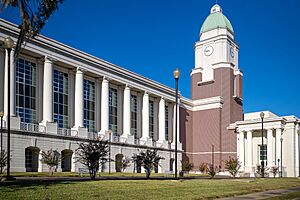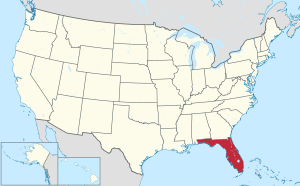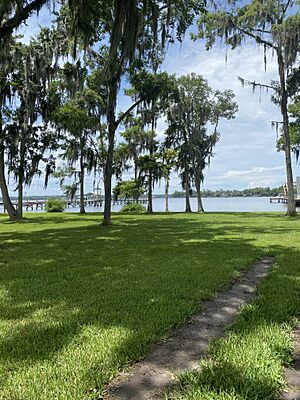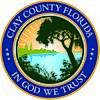Clay County, Florida facts for kids
Quick facts for kids
Clay County
|
|||
|---|---|---|---|

Clay County Courthouse
|
|||
|
|||
| Motto(s):
In God We Trust
|
|||

Location within the U.S. state of Florida
|
|||
 Florida's location within the U.S. |
|||
| Country | |||
| State | |||
| Founded | December 31, 1858 | ||
| Named for | Henry Clay | ||
| Seat | Green Cove Springs | ||
| Largest city | Lakeside | ||
| Area | |||
| • Total | 644 sq mi (1,667 km2) | ||
| • Land | 604 sq mi (1,566 km2) | ||
| • Water | 39 sq mi (101 km2) 6.1% | ||
| Population
(2020)
|
|||
| • Total | 218,245 | ||
| • Estimate
(2023)
|
232,439 |
||
| • Density | 380/sq mi (148/km2) | ||
| Time zone | UTC−5 (Eastern) | ||
| • Summer (DST) | UTC−4 (EDT) | ||
| ZIP Codes |
32003, 32043, 32065, 32068, 32073, 32079, 32091, 32234, 32656, 32666
|
||
| Area code | 352, 904, 324 | ||
| Congressional district | 4th | ||
Clay County is a county in the northeastern part of Florida. It sits along the west side of the St. Johns River. In 2020, about 218,245 people lived here. By 2023, the population grew to 232,439. This makes it the third largest county in the Jacksonville area.
Most of Clay County is made up of smaller communities. But it also has four towns and cities. Green Cove Springs is the county seat, which means it's where the county government is located. The largest community is Lakeside. The county is named after Henry Clay, a famous American leader from the 1800s. He was a senator and Secretary of State.
Since 1990, Clay County has become a mostly suburban area. This means many people live in neighborhoods and commute to work in nearby cities. It has the third highest average household income in Florida. Many people who live here work in Jacksonville or other nearby cities like St. Augustine. Because of this, over half of the workers in Clay County travel to another county for their jobs. This makes the average commute time almost 33 minutes. The population is expected to grow even more by 2040. New roads like the First Coast Expressway are being built to help with traffic.
Clay County has a rich military history. Important military places like Branan Air Field, Naval Air Station Green Cove Springs, and Camp Blanding are located here. The county is also a popular spot for tourists. It has many beautiful lakes like Kingsley Lake, Lake Asbury, and Doctors Lake. Black Creek also flows through the middle of the county.
Contents
History
In the early 1800s, a man named Zephaniah Kingsley had a large farm called Laurel Grove Plantation. It was located where Orange Park is today.
Clay County was officially created on December 31, 1858. It was formed from a part of Duval County. In the past, the area was a popular place for tourists. They loved its natural springs and mild weather. Steamboats would bring visitors to hotels in Green Cove Springs. Even President Grover Cleveland visited and had spring water sent to the White House! Clay County was most popular for tourism in the late 1800s. But then, Henry Flagler built his Florida East Coast Railway to other places like Palm Beach and Miami. This made tourism in Clay County less popular.
The military has always been important to Clay County. In 1939, Camp Blanding opened near Kingsley Lake. This huge area was developed by the Florida National Guard. During World War II, over 90,000 soldiers trained there. It became the fourth-largest "city" in Florida at that time. In Green Cove Springs, Lee Field was a place for flight training. After the war, Lee Field became a base for storing old ships. Lee Field closed in the 1960s, but Camp Blanding is still used for military training today. Many military families also choose to live in Clay County. They work at bases in nearby Duval County.
Geography

Clay County covers about 644 square miles. About 604 square miles are land, and 39 square miles are water. The county is about 95 feet above sea level on average. The highest point is 259 feet, located in Camp Blanding. The southwestern part of the county has many lakes. These lakes help fill the Floridan Aquifer. This is an important source of water for the whole region.
In the 2000s, many lakes started to dry up because more people needed water. To help with this, a project started in 2022. A pipeline is being built from Black Creek to Alligator Creek. This pipeline should help bring the lake levels back up.
Clay County is also home to several protected natural areas. These include Goldhead Branch State Park, Belmore State Forest, and Jennings State Forest. These areas protect many native plants and animals. They also create a natural space around Camp Blanding.
Neighboring counties
- Duval County, Florida - north
- St. Johns County, Florida - east
- Putnam County, Florida - south
- Bradford County, Florida - west
- Baker County, Florida - northwest
Transportation
Airports
- Keystone Heights Airport
Railroads
- CSX A-Line - This line runs north to south through the eastern part of the county.
- CSX S-Line - This line briefly goes through the northwest corner of the county.
Major highways
 US 17
US 17 US 301
US 301 SR 16
SR 16 SR 21
SR 21 SR 23
SR 23 SR 100
SR 100
Before 2019, Clay County was the largest county in Florida without a major highway that had limited access (like an interstate). The First Coast Expressway project is changing this. When finished, it will connect Interstate 10 in Jacksonville to Interstate 95. It will also replace the old Shands Bridge with a new, bigger one.
Public transportation
- Clay Community Transportation - This is a shuttle service with four routes around the county. It's run by the Jacksonville Transportation Authority.
- Clay Express-Select - This is a bus service that takes riders from Orange Park and Fleming Island to downtown Jacksonville.
Population facts
| Historical population | |||
|---|---|---|---|
| Census | Pop. | %± | |
| 1860 | 1,914 | — | |
| 1870 | 2,098 | 9.6% | |
| 1880 | 2,838 | 35.3% | |
| 1890 | 5,154 | 81.6% | |
| 1900 | 5,635 | 9.3% | |
| 1910 | 6,116 | 8.5% | |
| 1920 | 5,621 | −8.1% | |
| 1930 | 6,859 | 22.0% | |
| 1940 | 6,468 | −5.7% | |
| 1950 | 14,323 | 121.4% | |
| 1960 | 19,535 | 36.4% | |
| 1970 | 32,059 | 64.1% | |
| 1980 | 67,052 | 109.2% | |
| 1990 | 105,986 | 58.1% | |
| 2000 | 140,814 | 32.9% | |
| 2010 | 190,865 | 35.5% | |
| 2020 | 218,245 | 14.3% | |
| 2023 (est.) | 232,439 | 21.8% | |
| U.S. Decennial Census 1790-1960 1900-1990 1990-2000 2010-2019 |
|||
Recent population changes
| Racial Composition | 2022 | 2020 | 2010 | 2000 |
|---|---|---|---|---|
| White alone (non-Hispanic) | 69.3% | 68.3% | 77.2% | 84.9% |
| Black alone (non-Hispanic) | 12.7% | 11.7% | 9.5% | 6.6% |
| Hispanic or Latino | 11.4% | 10.6% | 7.7% | 4.3% |
| Asian alone (non-Hispanic) | 3.1% | 3% | 2.8% | 2% |
| Other Race alone (non-Hispanic) | 0.6% | 1% | 0.6% | 0.6% |
| Two or more races (non-Hispanic) | 2.9% | 5.4% | 2.2% | 1.6% |
| Population | 226,589 | 218,245 | 190,865 | 140,814 |
In 2022, Clay County's population grew to 226,589 people. This growth happened because many people moved into the county. Since 2020, over 9,100 people have moved to Clay County. Most of these new residents came from other parts of the United States.
Since 2020, there have been more deaths than births in the county. This means the population growth is mainly due to people moving in. The average age in Clay County is now about 40.5 years old.
Families and income
In 2020, there were 218,245 people living in Clay County. About 10.6% of the population were Hispanic or Latino. The rest were from various racial backgrounds.
In 2021, the average age in Clay County was 40.9 years. About 25.6% of residents were under 20 years old. There were over 80,000 households in the county. About 31.9% of these households had children under 18 living with them. The average household had 2.75 people.
The average income for a household in the county was $76,679. For families, it was $85,196. About 7.1% of the population lived below the poverty line. This included 13.5% of children under 18.
Many people in Clay County have Irish, English, or German backgrounds. About 45% of residents were born in Florida. Another 46% were born in other states. Many people move here from other Southern states and the Northeast. There is also a growing community of Puerto Ricans in Clay County.
Clay County has the second highest number of Filipino immigrants in Florida. About 1.1% of residents are from the Philippines. Overall, 6.1% of residents were born in another country. Most of them have become U.S. citizens.
| Foreign-born
Population in Clay County |
Percentage of
Clay County Population |
Foreign-born
Population in Florida |
Percentage of
Florida Population |
|
|---|---|---|---|---|
| Philippines | 2,449 | 1.1% | 88,318 | 0.4% |
| Mexico | 1,097 | 0.5% | 287,765 | 1.3% |
| Cuba | 715 | 0.3% | 973,959 | 4.5% |
| Haiti | 645 | 0.3% | 341,943 | 1.6% |
| Peru | 534 | 0.3% | 89,858 | 0.4% |
| Canada | 492 | 0.2% | 94,586 | 0.4% |
| El Salvador | 489 | 0.2% | 43,975 | 0.2% |
| Guatemala | 436 | 0.2% | 102,110 | 0.5% |
| India | 429 | 0.2% | 97,800 | 0.5% |
| China | 408 | 0.2% | 48,308 | 0.2% |
| Language Spoken at Home | 2019 | 2010 | 2000 | 1980 |
|---|---|---|---|---|
| English | 89.3% | 90.5% | 92.3% | 96.4% |
| Spanish | 6.4% | 5.2% | 4.2% | 1.4% |
| Tagalog | 1.4% | 1% | 0.9% | 0.3% |
| German or West Germanic Languages | 0.6% | 0.4% | 0.5% | 0.4% |
| French, Haitian, or Cajun | 0.5% | 0.6% | 0.5% | 0.4% |
| Other Languages | 1.8% | 2.3% | 1.6% | 1.1% |
Museums
- Clay County Historical and Railroad Museum, Green Cove Springs
- Middleburg Historical Museum, Middleburg
- Black Heritage Museum, Middleburg
- Camp Blanding Museum, Camp Blanding
Education
The Clay County School District runs 42 public schools. This includes 28 elementary schools, five junior high schools, six high schools, and one junior/senior high school.
In the 2021-22 school year, the school district earned an "A" grade from the Florida Department of Education. It was ranked the tenth best school district in the state. In 2023, U.S. News & World Report named Fleming Island High School the top high school in Clay County. It was ranked 91st in all of Florida.
Libraries
The Clay County Public Library System has five different locations:
- Green Cove Springs Library
- Headquarters Library (Fleming Island)
- Keystone Heights Library
- Middleburg-Clay Hill Library
- Orange Park Library
The first public library in Clay County was a small collection of books. It was started by a local group. In 1961, women's groups in the county worked to create a county-wide library system. Because of their efforts, the first public library opened in Green Cove Springs in 1961. This library even had a bookmobile in 1962. It brought books to different areas of the county.
Two more libraries opened in 1962 in Keystone Heights and Orange Park. The Keystone Heights Library burned down in 1962 but reopened in a new building in 1964. As the population grew, new libraries were built. The Headquarters Library opened in 1970. The Orange Park Library moved to a bigger spot in 1976. The Middleburg-Clay Hill Library opened in the late 1970s. Its permanent building was finished in 1986.
Communities
Cities
Towns
Census-designated places
Other communities
See also
 In Spanish: Condado de Clay (Florida) para niños
In Spanish: Condado de Clay (Florida) para niños




